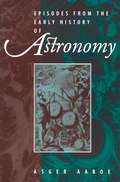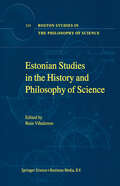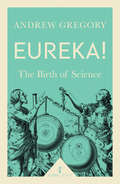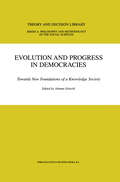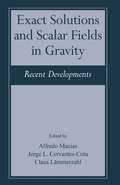- Table View
- List View
Environmental External Costs of Transport
by Peter Bickel Rainer FriedrichTransport is very important for the economy and our welfare. However, transport also causes a lot of problems, including air pollution. Such problems should be taken into account, when making decisions. A prerequisite for doing so is, that the impacts are known, quantitatively measured and allocated to the different activities in transport. Furthermore, they should be transformed into monetary units to be used as a basis for cost-benefit analyses or as an aid for setting taxes and charges, that reflect the external costs. This book describes a methodology for calculating impacts of transport activities and external costs caused by air pollution and presents numerous applications of this methodology for different transport technologies, locations and policy case studies. The approach has been developed and results have been calculated within the research project 'ExternE Core/Transport', financed to a large extent by the European Commission, Directorate General Research. We would like to thank especially Pierre Vallette and Pekka Jarviletho from the EC for their advice and support. A considerable number of experts with expertise in the different disciplines of this highly interdisciplinary work contributed to this book. The editors would like to thank the authors (see list on p. XV) for their contributions; it is especially remarkable, that the authors helped to make this book an integrated whole instead of a number of independent contributions.
Environmental Management Plans Demystified: A Guide to ISO14001
by Stephen TinsleyThe development of an environmental management plan is an essential business activity that helps organise, direct and control operational activities, and plan for future environmental risk. Once created, an environmental management plan is an ongoing asset that requires regular updating and enables benchmarking against company targets and competitors. Environmental Management Plans Demystified takes you step-by-step through the process and procedures required to implement a successful plan. Its clear, accessible style allows you to achieve ISO 14001 compliance with the minimum of effort. Examples of standard documentation, case studies, flowcharts, and checklists are included, as well as useful hints to avoid resource-wasting pitfalls. If you want to install a successful environmental management plan that will minimise environmental risk and create a competitive advantage for your company, this book is an essential practical guide for both the absolute beginner and the experienced practitioner.
Environmental Management Plans Demystified: A Guide to ISO14001
by Stephen TinsleyThe development of an environmental management plan is an essential business activity that helps organise, direct and control operational activities, and plan for future environmental risk. Once created, an environmental management plan is an ongoing asset that requires regular updating and enables benchmarking against company targets and competitors. Environmental Management Plans Demystified takes you step-by-step through the process and procedures required to implement a successful plan. Its clear, accessible style allows you to achieve ISO 14001 compliance with the minimum of effort. Examples of standard documentation, case studies, flowcharts, and checklists are included, as well as useful hints to avoid resource-wasting pitfalls. If you want to install a successful environmental management plan that will minimise environmental risk and create a competitive advantage for your company, this book is an essential practical guide for both the absolute beginner and the experienced practitioner.
Environmental Monitoring and Biodiagnostics of Hazardous Contaminants
by M. Healy D. L. Wise Murray Moo-YoungIn recent years public awareness of the long term toxic affects heavy metal ions in waters and wastewaters has increased significantly. Environmental agencies have been imposing more and more stringent discharge limits on industries involved in processes using metal ions. Numerous industries produce aqueous effluents con taining metal ions and particularly copper and cadmium. Copper sulfate is used on a large scale in the electroplating industries. In addition, copper salts are used as fungicides, timber preservatives, insecticides, paint corrosion inhibitors and in dyestuffs. Cadmium is used in the manufacture of nickel-cadmium batteries, as a corrosion inhibitor and control rods in the nuclear industry. The European Com munity has listed cadmium as one of the most dangerous metal due to its toxicity, persistence and bioaccumulation in List 1 of its Directive 76/464/EEC. Therefore, it is important that methods for the removal of these metal ions are found and that the mechanism of removal is characterized and understood. A number of adsorb ents have been identified which are capable of removing copper (Panday et aI. , 1985; Ho et aI. , 1996; Low and Lee, 1987; Low et aI. , 1993; Quek et aI. , 1998) and cadmium (Battacharya and Venkobachar, 1984; Namasivayam and Ranganathan, 1995; Periasamy and Namasivayam, 1994) from aqueous solutions. Sorption kin etic models have been proposed for some systems.
Environmental Policy Analysis for Decision Making (The Economics of Non-Market Goods and Resources #1)
by J. Loomis Gloria Helfand1. ENVIRONMENTAL POLICY ANALYSIS: WHAT AND WHY? Why environmental policy analysis? Environmental issues are growing in visibility in local, national, and world arenas, as a myriad of human activities leads to increased impacts on the natural world. Issues such as climate change, endangered species, wilderness protection, and energy use are regularly on the front pages of newspapers. Governments at all levels are struggling with how to address these issues. Environmental policy analysis is intended to present the environmental and social impacts of policies, in the hope that better decisions will result when people have better information on which to base those decisions. Conducting environmental policy analysis requires people who understand what it is and how to do it. Interpreting it also requires those skills. We hope that this book will increase the abilities, both of analysts and of decision-makers, to understand and interpret the impacts of environmental policies. Policy analysis books almost invariably begin by pointing out that policy analysis can take many forms. This book is no different. As you will see in Chapter 1, we consider policy analysis to be information provided for the policy process. That information can take many forms, from sophisticated empirical analysis to general theoretical results, from summary statistics to game theoretic strategies.
Enzymes in Nonaqueous Solvents: Methods and Protocols (Methods in Biotechnology #15)
by Evgeny N. Vulfson, Peter J. Halling and Herbert L. HollandEnzymatic catalysis has gained considerable attention in recent years as an efficient tool in the preparation of natural products, pharmaceuticals, fine chemicals, and food ingredients. The high selectivity and mild reaction con- tions associated with enzymatic transformations have made this approach an attractive alternative in the synthesis of complex bioactive compounds, which are often difficult to obtain by standard chemical routes. However, the maj- ity of organic compounds are not very soluble in water, which was traditi- ally perceived as the only suitable reaction medium for the application of biocatalysts. The realization that most enzymes can function perfectly well under nearly anhydrous conditions and, in addition, display a number of useful properties, e. g. , highly enhanced stability and different selectivity, has d- matically widened the scope of their application to the organic synthesis. Another great attraction of using organic solvents rather than water as a reaction solvent is the ability to perform synthetic transformations with re- tively inexpensive hydrolytic enzymes. It is worth reminding the reader that in vivo, the synthetic and hydrolytic pathways are catalyzed by different enzymes. However, elimination of water from the reaction mixture enables the “reversal” of hydrolytic enzymes and thus avoids the use of the expensive cofactors or activated substrates that are required for their synthetic count- parts.
Eocene Biodiversity: Unusual Occurrences and Rarely Sampled Habitats (Topics in Geobiology #18)
by Gregg F. GunnellInitially, this work was designed to document and study the diversification of modern mammalian groups and was quite successful and satisfying. However, as field and laboratory work continued, there began to develop a suspicion that not all of the Eocene story was being told. It became apparent that most fossil samples, especially those from the American West, were derived from similar preservational circumstances and similar depositional settings. A program was initiated to look for other potential sources of fossil samples, either from non-traditional lithologies or from geographic areas that were not typically sampled. As this program of research grew it began to demonstrate that different lithologies and different geographic areas told different stories from those that had been developed based on more typical faunal assemblages. This book is conceived as an introduction to non-traditional Eocene fossils samples, and as a place to document and discuss features of these fossil assemblages that are rare or that come from rarely represented habitats.
Episodes From the Early History of Astronomy
by Asger AaboePhenomena in the heavens are of great importance to many, and much of the lore of astronomy and astrology dates back to the earliest days of civilisation. The astronomy of the ancients is thus of interest not only as history but also as the basis for much of what is known or believed about the heavens today. This book discusses important topics in Babylonian and Greek astronomy.
Epstein-Barr Virus and Human Cancer (Current Topics in Microbiology and Immunology #258)
by K. TakadaIn this book, outstanding researchers from the US and Japan review recent progress in Epstein-Barr virus research. Most people carry EBV in memory B-cells in a latent stage. Many malignancies such as T/NK cell lymphoma, AIDS-associated B-cell lymphoma, gastric carcinoma and Hodgkin's disease have been causally linked to EBV. The development of molecular biology technique has allowed us to study the roles of individual EBV genes that act in the maintenance and disruption of EBV latency.
Erfolgskontrolle von Umweltmaßnahmen: Perspektiven für ein integratives Umweltmanagement (Umweltnatur- & Umweltsozialwissenschaften)
by R. Bühlmann A. HeitzerErgodic Theory, Analysis, and Efficient Simulation of Dynamical Systems
by Bernold FiedlerPresenting very recent results in a major research area, this book is addressed to experts and non-experts in the mathematical community alike. The applied issues range from crystallization and dendrite growth to quantum chaos, conveying their significance far into the neighboring disciplines of science.
Ernst Mach's Vienna 1895-1930: Or Phenomenalism as Philosophy of Science (Boston Studies in the Philosophy and History of Science #218)
by J. T. Blackmore R. Itagaki S. TanakaSection Guide 1. Prolegomena 2. Biographical Sketch 3. Epistemology 4. Textbook Ontology 1. PROLEGOMENA While both philosophers and historians almost always love truth and the search for truth, and both often carry out extensive research, there can be noticeable differences when historians write about the history of philosophy and when philosophers write about it. Philosophers often look at the past with categories and interests taken from the present or at the least from the recent past, but many historians, especially those who love research for its own sake, will try to look at the past from a perspective either from that period or from even earlier. Both camps look for roots, but view them with different lenses and presupposi tions. This prolegomena has been added to prepare some philosophers for what will hopefully only be the mildest of shocks, for seeing the history of philosophy in a way which does not treat what is recent or latest as best, but which loves the context of ideas for its own sake, a context which can be very foreign to contemporary likes and dislikes. To be sure, we historians can deceive ourselves as easily as philosophers, but we tend to do so about different things.
Essays on the Motion of Celestial Bodies
by V.V. BeletskyInteresting and often unexpected achievements of the mechanics of space flight throw a new light onto several classical problems. The book’s emphasis is on analysis carried out on the level of graphs and drawings, and sometimes numbers, revealing the beauty of the research process leading to the results.
Essentials of Autopsy Practice: Volume 1
by Guy N. RuttyEssentials of Autopsy Practice is dedicated to updating the modern pathologist on the issues related to the autopsy. This first volume contains 12 topical chapters which are not covered in any other text. It comprises the most recent developments in current autopsy and relevant subjects that have not yet been covered in current autopsy textbooks. This is what makes this book exceptional in its field. The book will be of interest to both trainees and consultants in all sub-branches of pathology including forensic pathology. The subject matter will also appeal to other areas of clinical medicine and will make a good reference book.
Estimating Abundance of African Wildlife: An Aid to Adaptive Management
by Hugo JachmannEstimating abundance of wildlife is an essential component of a wildlife research program, and a prerequisite for sound management. With the exception of a few highly mathematical volumes, there are no books on the subject for use by students and field workers. Also, the various techniques for counting animals found in scientific journals are often not accessible to African managers. The unavailability of the diverse literature necessitated the production of a textbook or field manual that covers the ground. The book compiles the most relevant techniques for counting African mammals, illustrated with many examples from the field. It provides guidelines for selecting the appropriate methodology for a range of conditions commonly found in the field, in terms of different animal species, habitat types, and management objectives.
Estonian Studies in the History and Philosophy of Science (Boston Studies in the Philosophy and History of Science #219)
by Rein VihalemmThe development of geography also forms an interesting chapter in the history of the University ofTartu and in that of Estonian science in general. On the one hand, geography is a natural science in the broader sense ofthe word, on the other hand it is a study of human activity. This status of geography makes it particularly sensitive to the cultural and political circumstances under which scholarship and science have developed in Estonia. The article by Professor of Human Geography Ott Kurs (born 1939) and historian of science (PhD in geography) Erki Tamrniksaar (born 1969) "In Political Draughts Between Science and the Humanities: Geography at the University ofTartu Between the th th 17 -20 Centuries" is devoted to this topic. Among other things, the article states that regular instruction in geography started at the University of Tartu in 1826, when the second chair of geography in Europe was established here. Although the present book does not contain any studies on philosophy at th Tartu University in the 19 century, I would still like to mention two names. th In the early 19 century, I. Kant's philosophy was dominant at Tartu Uni versity. One of Kant's pupils, Gottlob Benjamin Jasche (1762-1839), who had worked under him as a Privatdozent in Konigsberg, served as a professor here from 1802-1839. In the history of philosophy he is primarily known as the publisher of Kant's Logic.
Estrogen — Mystery Drug for the Brain?: The Neuroprotective Activities of the Female Sex Hormone
by Christian BehlIt is well known that estrogen is "somehow” a protective hormone for various age-related disorders. This book provides a solid knowledge of estrogen’s neuroprotective activities in the brain with a special emphasis on neurodegenerative disorders such as Alzheimer’s Disease. The focus is (1) to describe the biochemical, molecular, and cellular basis of the protective activity of estrogen and (2) to transfer this knowledge into the hospitals by discussing preventive and therapeutic approaches such as estrogen replacement therapy for post-menopausal women. Besides up-to-date information on estrogen and the brain, this book explains in a highly understandable manner molecular and cellular techniques by which basic data have been collected. The reader, which may include the professional specialist as well as the interested non-specialist, will also gain insight into the scientific transfer process of knowledge from basic science to the clinical situation and therefore "from bench to bed”.
Ethics in Forensic Science: Professional Standards for the Practice of Criminalistics
by Peter D. BarnettWith the complexity of the interactions between the methodology of science, the principles of justice, and the realities of the practice of law and criminalistics, ethical issues frequently arise. One of the hallmarks of a profession is a code of ethics to govern the actions of members of the profession with one another, with users of the professio
Eugenics: A Reassessment (Human Evolution, Behavior, And Intelligence Ser.)
by Richard LynnLynn argues that the condemnation of eugenics in the second half of the 20th century went too far and offers a reassessment. The eugenic objectives of eliminating genetic diseases, increasing intelligence, and reducing personality disorders he argues, remain desirable and are achievable by human biotechnology. In this four-part analysis, Lynn begins with an account of the foundation of eugenics by Francis Galton and the rise and fall of eugenics in the twentieth century. He then sets out historical formulations on this issue and discusses in detail desirability of the new eugenics of human biotechnology. After examining the classic approach of attempting to implement eugenics by altering reproduction, Lynn concludes that the policies of classical eugenics are not politically feasible in democratic societies. The new eugenics of human biotechnology--prenatal diagnosis of embryos with genetic diseases, embryo selection, and cloning--may be more likely than classic eugenics to evolve spontaneously in western democracies. Lynn looks at the ethical issues of human biotechnologies and how they may be used by authoritarian states to promote state power. He predicts how eugenic policies and dysgenic processes are likely to affect geopolitics and the balance of power in the 21st century. Lynn offers a provocative analysis that will be of particular interest to psychologists, sociologists, demographers, and biologists concerned with issues of population change and intelligence.
Eureka!: The Birth of Science (Icon Science)
by Andrew GregoryMedicine, anatomy, astronomy, mathematics and cosmology, science began with the Greeks, and Plato, Aristotle, Pythagoras, Archimedes and Hippocrates were amongst its stars. That man ever managed to develop a 'scientific' attitude to the natural world at all is one of the true wonders of human thought. Eureka! shows how, free from intellectual and religious dogma, these early thinkers rejected myths and capricious gods and, in distinguishing between the natural and supernatural, effectively discovered nature. Andrew Gregory, Professor of History and Philosophy of Science at University College London, unravels the genesis of science in this fascinating exploration of the origins of Western civilisation, and our desire for a rational, legitimating system of the world.
Evolution and Progress in Democracies: Towards New Foundations of a Knowledge Society (Theory and Decision Library A: #31)
by Johann GötschlIn a ground-breaking series of articles, one of them written by a Nobel Laureate, this volume demonstrates the evolutionary dynamic and the transformation of today's democratic societies into scientific-democratic societies. It highlights the progress of modeling individual and societal evaluation by neo-Bayesian utility theory. It shows how social learning and collective opinion formation work, and how democracies cope with randomness caused by randomizers. Nonlinear `evolution equations' and serial stochastic matrices of evolutionary game theory allow us to optimally compute possible serial evolutionary solutions of societal conflicts. But in democracies progress can be defined as any positive, gradual, innovative and creative change of culturally used, transmitted and stored mentifacts (models, theories), sociofacts (customs, opinions), artifacts and technifacts, within and across generations. The most important changes are caused, besides randomness, by conflict solutions and their realizations by citizens who follow democratic laws. These laws correspond to the extended Pareto principle, a supreme, socioethical democratic rule. According to this principle, progress is any increase in the individual and collective welfare which is achieved during any evolutionary progress. Central to evolutionary modeling is the criterion of the empirical realization of computed solutions. Applied to serial conflict solutions (decisions), evolutionary trajectories are formed; they become the most influential causal attractors of the channeling of societal evolution. Democratic constitutions, legal systems etc., store all advantageous, present and past, adaptive, competitive, cooperative and collective solutions and their rules; they have been accepted by majority votes. Societal laws are codes of statutes (default or statistical rules), and they serve to optimally solve societal conflicts, in analogy to game theoretical models or to statistical decision theory. Such solutions become necessary when we face harmful or advantageous random events always lurking at the edge of societal and external chaos. The evolutionary theory of societal evolution in democracies presents a new type of stochastic theory; it is based on default rules and stresses realization. The rules represent the change of our democracies into information, science and technology-based societies; they will revolutionize social sciences, especially economics. Their methods have already found their way into neural brain physiology and research into intelligence. In this book, neural activity and the creativity of human thinking are no longer regarded as linear-deductive. Only evolutive nonlinear thinking can include multiple causal choices by many individuals and the risks of internal and external randomness; this serves the increasing welfare of all individuals and society as a whole. Evolution and Progress in Democracies is relevant for social scientists, economists, evolution theorists, statisticians, philosophers, philosophers of science, and interdisciplinary researchers.
The Evolution of Galaxies: I-Observational Clues
by José M. Vilchez Grazyna Stasinska Enrique PérezGalaxies have a history. This has become clear from recent sky surveys showing that distant galaxies, formed early in the life of the Universe, differ from the nearby ones. This book contains the proceedings of a 2000 conference addressing observational clues in this area.
Evolutionary Controversies in Economics: A New Transdisciplinary Approach
by Japan Association Japan Association for Evolutionary Economics Y. ArukaIn March 1997, we launched the Japan Association for Evolutionary Economics {JAFEE) to gather the academic minds that, out of dissatisfaction with established dynamic approaches, were separately searching for new approaches to economics. To our surprise and joy,as many as 500members, including graduate students,joined us. Later that year Prof. Horst Hanusch, then President of the International [oseph A. Schumpeter Society, remarked that such a start would take a couple of decades in Europe to prepare for. Since then we have been developing our activities incessantly not only in terms of the number of members, but also in terms of the intensity of international academic exchange. Originally the planning of this book came about as the successful outcome of our fourth annual conference organized as an international one, JAFEE 2000.Incorporat ing other international contributions related to our preceding conferences, this book has eventually turned out to be one of the most enterprising anthologies on evolu tionary economics ever published. Specifically, it contains excellent papers on such topics as streams of evolutionary economics, evolutionary nonlinear dynamics, experimental economics and evolution, multiagent systems and complexity, new frontiers for evolutionary economics, and economic heresies. In short, this book will provide a vivid and full-fledged picture of up-to-date evolutionary economics.
Evolutionsbiologie (Springer-Lehrbuch)
by V. Storch U. Welsch M. WinkEin modernes, topaktuelles Lehrbuch zu einem klassischen Fachgebiet der Biologie: Molekularbiolgische Forschungsansätze werden ebenso behandelt wie die verschiedenen Evolutionstheorien; die unterschiedlichen Lehrmeinungen werden sachlich einander gegenübergestellt; "molekulare Fenster" (z.B. die Evolution einzelner Gene), die Einblick in spezifische evolutionsbiologische Fragestellungen gewähren, werden aufgezeigt; die Evolution des Menschen ist ein weiteres wesentliches Thema. Das Buch bietet mit ausgefeilter Didaktik alle Aspekte der Evolution für Anfänger und Fortgeschrittene. Zahlreiche Abbildungen, ausgewählte Beispiele und Boxen, in denen aktuelle Techniken, große Forscher oder historische Meilensteine beleuchtet werden, geben einen abgerundeten Überblick über dieses grundlegende biologische Thema.
Exact Solutions and Scalar Fields in Gravity: Recent Developments
by Alfredo Macías Jorge L. Cervantes-Cota Claus LämmerzahlDivided into four parts, this book covers recent developments in topics pertaining to gravity theories, including discussions on the presence of scalar fields. Part One is devoted to exact solutions in general relativity, and is mainly concerned with the results of rotating null dust beams and fluids. Also included is a panoramic vision of new research directions in this area, which would require revising certain theorems and their possible extensions within gravity theories, new aspects concerning the Ernst potentials, double Kerr spacetimes, and rotating configurations. In particular, there is a detailed discussion of totally symmetric and totally geodesic spaces, in which a method for generating (2+1)-dimensional solutions from (3+1)-dimensional solutions is given. Part Two deals with alternative theories of gravity, all of which include scalar fields and gauge fields. Here, quantum and cosmological effects, which arise from both gravity theories in four and higher dimensions and from metric-affine theories, are investigated. Part Three is devoted to cosmological and inflationary scenarios. Local effects, such as the influence of scalar fields in protogalactic interactions, numerical studies of the collapse of molecular cores, as well as the inverse inflationary problem and the blue eigenvalue spectrum of it, are considered. Moreover, the role of scalar fields as dark matter and quantum cosmology in the Bergman-Wagoner and Gowdy theories, together with the relation of the conformal symmetry and deflationary gas universe, are likewise presented. The last part of the book includes some mixed topics which are still in the experimental stage. Among them are the foundation of the Maxwell theory, a discussion on electromagnetic Thirring problems, a note on the staticity of black holes with non-minimally coupled scalar fields, and a study of the Lorentz force free charged fluids in general relativity. Thus, this book is the most up-to-date, comprehensive collection of papers on the subject of exact solutions and scalar fields in gravity and is a valuable tool for researchers in the area.






